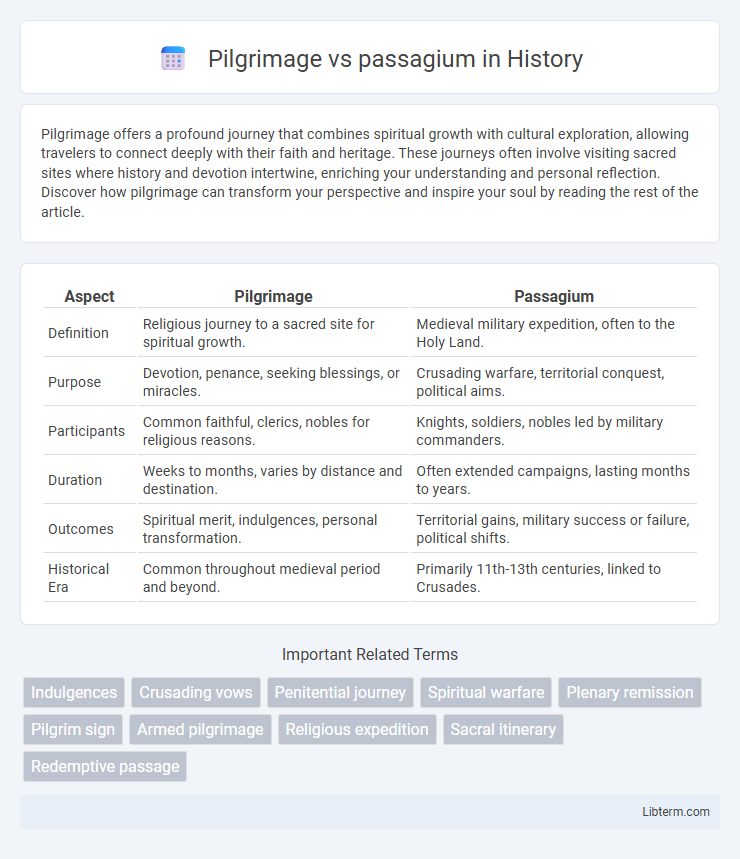Pilgrimage offers a profound journey that combines spiritual growth with cultural exploration, allowing travelers to connect deeply with their faith and heritage. These journeys often involve visiting sacred sites where history and devotion intertwine, enriching your understanding and personal reflection. Discover how pilgrimage can transform your perspective and inspire your soul by reading the rest of the article.
Table of Comparison
| Aspect | Pilgrimage | Passagium |
|---|---|---|
| Definition | Religious journey to a sacred site for spiritual growth. | Medieval military expedition, often to the Holy Land. |
| Purpose | Devotion, penance, seeking blessings, or miracles. | Crusading warfare, territorial conquest, political aims. |
| Participants | Common faithful, clerics, nobles for religious reasons. | Knights, soldiers, nobles led by military commanders. |
| Duration | Weeks to months, varies by distance and destination. | Often extended campaigns, lasting months to years. |
| Outcomes | Spiritual merit, indulgences, personal transformation. | Territorial gains, military success or failure, political shifts. |
| Historical Era | Common throughout medieval period and beyond. | Primarily 11th-13th centuries, linked to Crusades. |
Understanding Pilgrimage: Definition and Origins
Pilgrimage refers to a voluntary journey to a sacred site or religious destination, often motivated by devotion, penance, or seeking spiritual enlightenment. Its origins trace back to ancient religious practices, such as the Islamic Hajj, Christian pilgrimages to Jerusalem, and Hindu journeys to the Ganges River, embodying a quest for divine connection. Unlike passagium, a historical term linked to medieval crusading military expeditions, pilgrimage emphasizes personal faith and transformation over armed conquest.
What is Passagium? Historical Context
Passagium refers to a medieval military expedition or journey undertaken primarily by European crusaders during the 11th to 13th centuries, aimed at capturing or defending territories in the Holy Land or other strategic regions. Unlike pilgrimage, which was a religious journey for penance or spiritual devotion to sacred sites, a passagium combined religious motivations with military objectives, often involving armed conflict and territorial conquest. The term highlights the dual nature of crusading efforts, blending piety with warfare in the context of medieval Christendom's expansionist campaigns.
Key Differences: Pilgrimage vs. Passagium
Pilgrimage primarily refers to a religious journey undertaken by individuals to sacred sites for spiritual growth or penance, while passagium is a medieval Latin term originally denoting a military expedition or crusade. Key differences include purpose and context: pilgrimage emphasizes personal piety and devotion, whereas passagium involves organized military campaigns often sanctioned by religious authorities. Pilgrimage typically entails peaceful travel toward holiness, whereas passagium implies armed conflict aimed at reclaiming or defending territories.
Religious Motivations Behind Pilgrimages
Religious motivations behind pilgrimages center on seeking spiritual growth, penance, and divine favor by visiting sacred sites associated with saints, miracles, or holy relics. Unlike the broader concept of passagium, which historically refers to military expeditions like the Crusades, pilgrimages emphasize personal devotion and religious fulfillment. Pilgrimage destinations such as Santiago de Compostela, Mecca, or Varanasi serve as tangible connections to faith that inspire believers to undertake arduous journeys for spiritual transformation.
Military and Political Purposes of Passagium
Passagium, unlike traditional pilgrimage primarily motivated by religious devotion, carried significant military and political purposes, often serving as a precursor to larger crusading campaigns. It involved smaller, more strategic expeditions aimed at securing territorial control, gathering intelligence, or supporting allied forces in contested regions. These operations enhanced political influence and reinforced military presence, shaping power dynamics in border areas and influencing diplomatic relations during the Crusades.
Routes and Destinations Compared
Pilgrimage routes predominantly lead to sacred religious sites such as Jerusalem, Santiago de Compostela, and Mecca, emphasizing spiritual journeying and ritual observance. Passagium, a term rooted in medieval crusading expeditions, typically refers to military campaigns directed mainly toward the Holy Land or other strategic territories, highlighting geopolitical objectives alongside religious motivations. The contrasting destinations reflect pilgrimage's devotional focus versus passagium's blend of martial conquest and religious purpose across routes extending from Western Europe to Eastern Mediterranean regions.
Participants: Who Took Part in Each Journey?
Pilgrimage participants primarily included devout Christians seeking spiritual merit, often traveling alone or in small groups to sacred sites like Jerusalem, Rome, or Santiago de Compostela. Passagium, specific to the medieval crusading movement, involved organized military expeditions composed mainly of knights, nobles, soldiers, and occasionally peasants mobilized to reclaim or defend territories in the Holy Land. The distinction lies in pilgrimage's individual or communal religious devotion versus passagium's militarized, collective objective aligned with papal authority.
Societal Impact of Pilgrimage and Passagium
Pilgrimage and passagium significantly shaped medieval societal structures by fostering cultural exchange, economic development, and religious unity across diverse regions. Pilgrimage routes facilitated the growth of towns and commerce, while passagium--military expeditions often linked to religious motives--stimulated political alliances and territorial expansion. Both practices reinforced social hierarchies and collective identity through shared spiritual and martial experiences, driving profound transformations in medieval society.
Transformations Over Time: From Pilgrimage to Passagium
Pilgrimage evolved from a primarily religious journey into the passagium, a term reflecting both military expeditions and crusading campaigns during the medieval period, illustrating a shift from personal piety to political and military objectives. The transformation is marked by the 11th and 12th centuries, when European powers increasingly framed their travels as passagia to legitimize armed pilgrimage ventures aimed at reclaiming territories. This semantic shift underscores changes in medieval societal structures, showing how spiritual journeys adapted to broader geopolitical contexts, intertwining faith with warfare.
Legacy Today: Modern Interpretations and Practices
Pilgrimage and passagium have distinct legacies influencing modern spiritual journeys and religious tourism; pilgrimage often denotes a personal quest for sacred connection, while passagium historically refers to crusading expeditions with military and religious motives. Contemporary interpretations emphasize pilgrimage as a form of introspective travel promoting cultural exchange and spiritual growth, contrasting with passagium's legacy rooted in territorial conquest and religious conflict. Today, pilgrimage routes like the Camino de Santiago inspire millions worldwide, reflecting enduring traditions adapted to modern secular and interfaith contexts.
Pilgrimage Infographic

 libterm.com
libterm.com